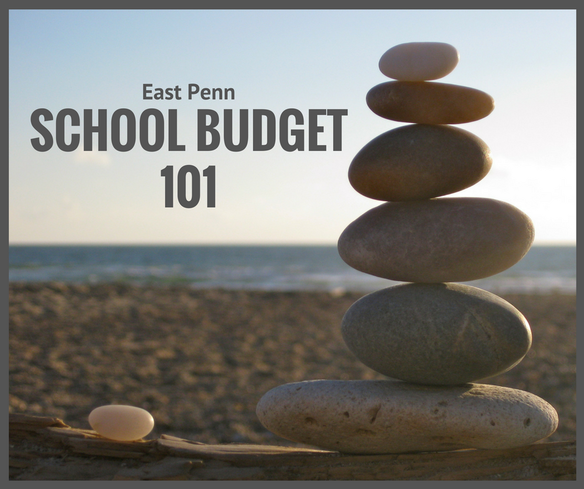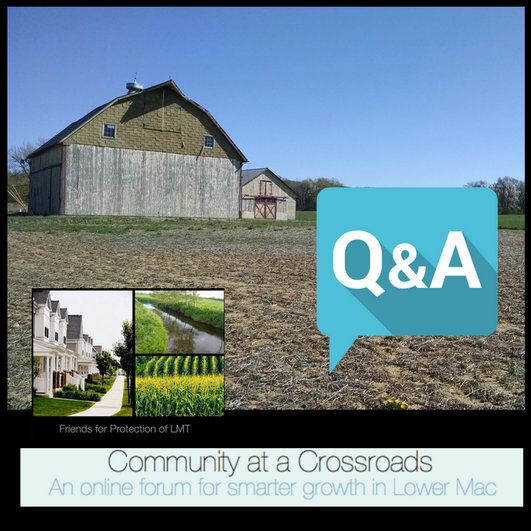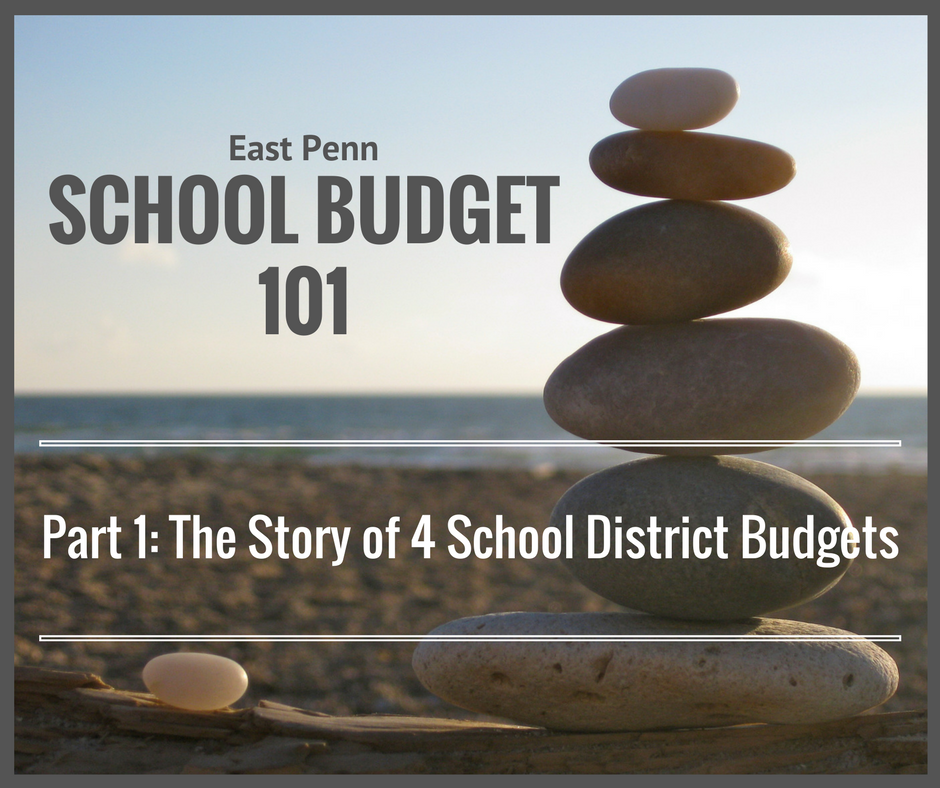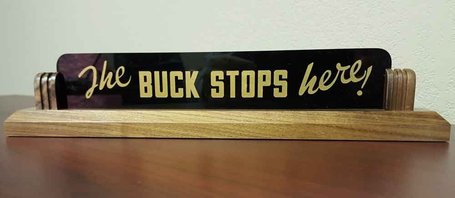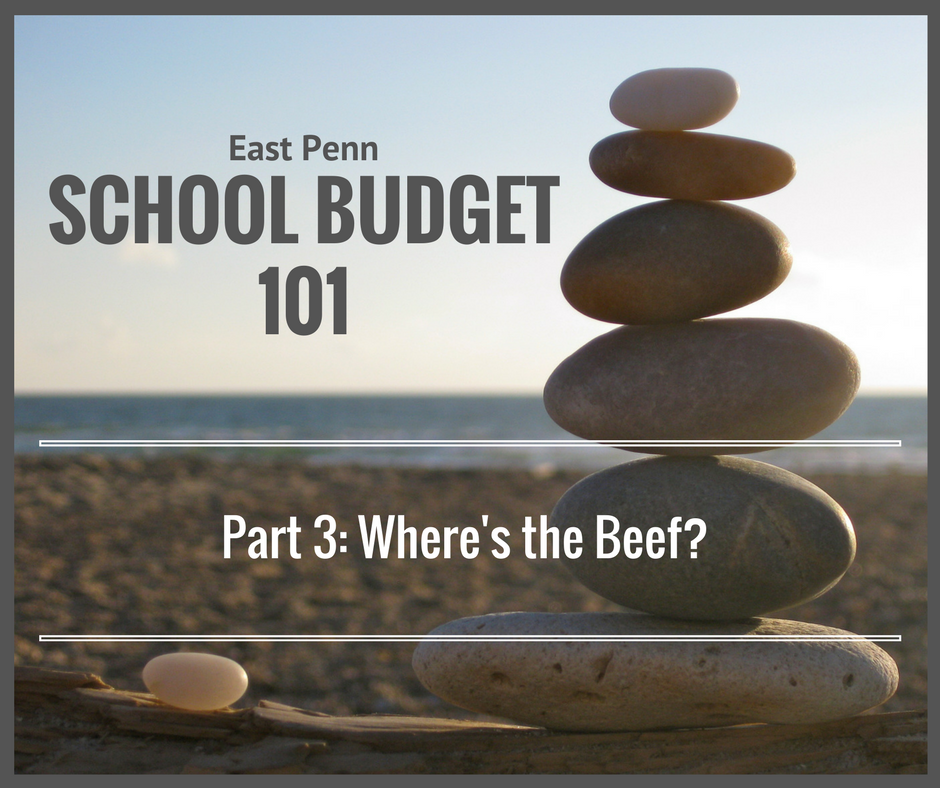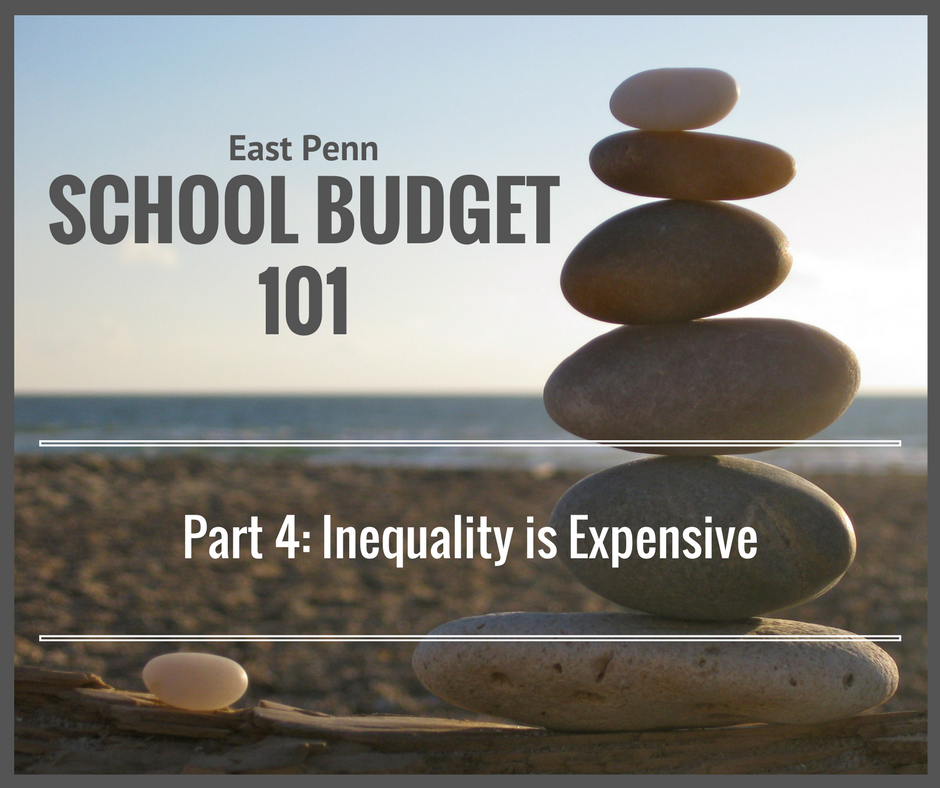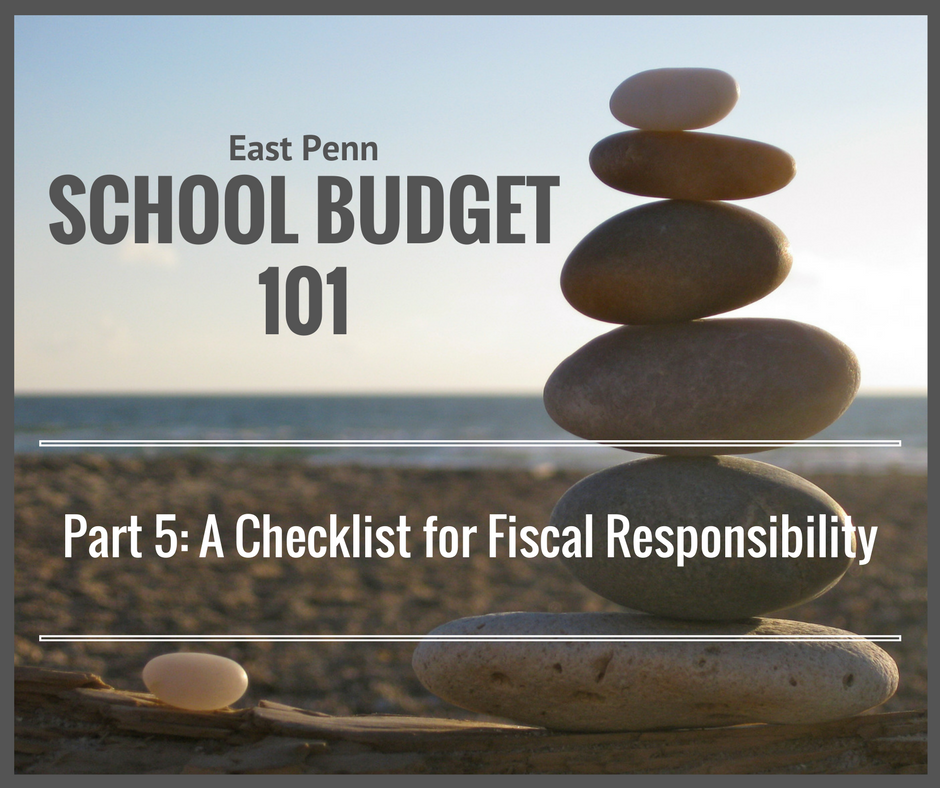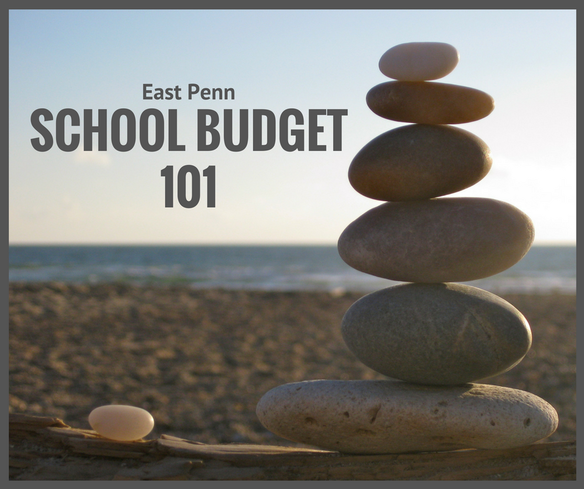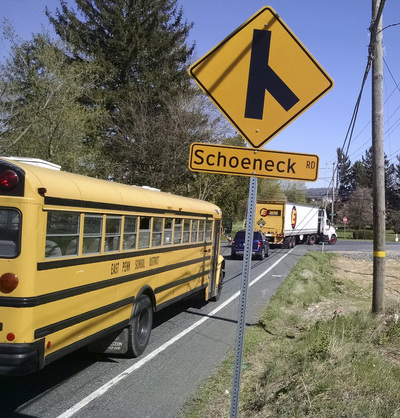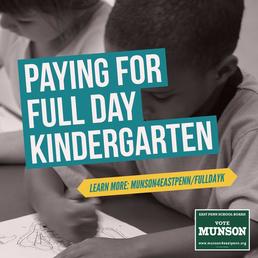
The East Penn School Board will vote soon on whether to offer full day kindergarten to all families in the district. I’m strongly in favor of doing so. I’ve already outlined some of the benefits of full day kindergarten, as well as our community’s need for it. But how do we pay for it?
The best estimate of the costs for a district wide full day kindergarten program is $1.1 million in the first year, and about $520,000 in subsequent years. This represents about 0.8% of the district’s total budget in the first year, and 0.4% of the budget in the following years. First Year Full Day Kindergarten Cost Estimate
The good news is that the money for full day kindergarten does not necessarily have to come from higher taxes. This is because the district will finish paying some debts this year, resulting in a $2.7 million dollar savings in debt costs in 2018-2019. These savings will more than cover the costs of full day kindergarten, with over $1.6 million left to be potentially used for both tax relief and other educational programs.
Universal full day kindergarten also helps the district use its tax dollars more efficiently. Our current half day programs require additional school bus runs during the day. Moving to full day kindergarten allows the district to save approximately $330,000 annually on reduced busing costs (included in the cost estimate above). This means our community is getting more bang for its buck by moving to a full day program. There is also the issue of the return on our community’s investment in full day kindergarten. Studies show that every $1 devoted to early childhood education today results in between $7 and $17 in future cost savings. These savings come from the prevention of expensive remedial education, special education and, later, social welfare, policing, and prison costs. This same principle applies to kindergarten programs as well. Can we afford full day kindergarten? I think the information above suggests that the answer is yes. But when you start looking at the potential return on investment of such programs, perhaps a better question is, can we afford NOT to have full day kindergarten? My support of full day kindergarten is not one I come to lightly; my opinion is based on talking to many people in the district about the issue, researching it on my own, reading what published studies say about the advantages and costs of such programs, and participating in three formal school board presentations and discussions on the issue over the last eighteen months. On the basis of this work, I’ve come to the conclusion that full day kindergarten is right for our district. What do you think? This is one of several posts on the full day kindergarten proposal. You can learn more at:
1 Comment
Monday was the last day of school in East Penn, and it also marked the school board’s final vote to approve the budget for next fall.
The district will spend approximately $149 million in 2017-2018, which requires a tax increase of 2.19%. This last number is sometimes the only number people look at when evaluating district spending. But it doesn’t tell the whole story. Over the course of the last few months, the administration and board have been able to steadily reduce that tax increase, from 3.77% initially, then 2.9% just last month. The final 2.19% is less than the amount allowed by state law and below the overall rate of inflation (currently 2.2%). The district’s spending per student is also lower than both the state and county averages (click here for data). And yet East Penn provides opportunities, experiences, and outcomes for students that are far above average. The final budget does not provide many of the things we might wish for our schools. It includes budget cuts in several areas. But it does maintain our excellent programs in the arts, music, and athletics. It also expands the science program in the elementary schools, special education at the high school, and fully funds the first of three stages in improving the district’s educational technology. As anyone who has managed even a family budget knows, the budgeting process is always a process of compromise and balancing different needs. Next year’s district budget isn’t perfect, but I think it is a good compromise that balances the different needs of our community. Are you feeling frustrated or concerned about the budget process in our district? Or just want to learn more about it? I’ve put together a series of short articles on the budget to help. Please check them out by clicking below: Friends for the Protection of Lower Macungie Township, an active group that promotes smart growth in the community, recently sent a number of questions to those running for the East Penn School Board for the first time. Though I am an incumbent, they asked great questions and so I thought I would answer them too: QUESTION: By a narrow 5-4 vote East Penn supported the Hamilton Crossings TIF. If a similar issue were to come up again what would your position be? I voted against the Hamilton Crossings TIF within the first few months of becoming a board member. The TIF takes half of the tax revenue generated by the Hamilton Crossings retail center and diverts it away from the schools in order to pay debts incurred in developing the property. I voted no because I believed that the developers would build Hamilton Crossings even without the support of the taxpayer money generated by the TIF. Hamilton Crossings now generates more than $600,000 annually in tax dollars to the school district, which is great. But I wish we could benefit from the more than $1.2 million that the district would receive annually without the TIF in place. QUESTION: Last year, the School District ignored a formal letter from the Lower Macungie Twp. Planning Commission opposing the sale of the Lower Macungie Elementary School Property. Multiple Lower Macungie Commissioners have gone on record expressing their disappointment (Beitler, Higgins). They both claimed that if given the chance, Lower Macungie Twp. would have considered making an offer on the property to preserve it. Apparently there was a lack of communication between the township and school district administration prior to an agreement of sale. If elected how would you ensure this lack of communication is addressed moving forward? The way this sale was handled is my single biggest regret from my four years on the school board. The district got a good deal on the property and selling it was the right thing to do (see Questions about Property Sale for details). But I was unaware at the time that the township was interested in preserving the land and might be willing to purchase it themselves. I wish we could have explored that option. The township concerns about the sale were raised only after the district had entered into a formal purchase agreement with the buyer. I agree that there needs to be better communication between township and the school district administration, and that such communication might have led to a different outcome with the Lower Macungie Elementary School property. I now regularly ask more questions of the administration about coordination and communication with the townships and boroughs that make up the district. As a board member, I now pay greater attention to the details of township and borough business than I did in the past. Moving forward, I think two specific changes to the way of doing business would help. First, I would like to see greater transparency in school board meetings by making them available through internet streaming or local cable television. This would allow everyone in the community, including municipal officials, to be better aware of school district issues. Second, I would like to see school administration and municipal officials establish a regular schedule of meetings to discuss issues of mutual concern. Such meetings need not be lengthy nor lead to any specific cooperation. But it would increase the flow of information between these community leaders and avoid missed opportunities like this one. QUESTION: The School District owns property off of Rt. 100. We have expressed concerns that with the proliferation of warehouses and freight traffic along Rt. 100 that this is no longer a safe or desirable location for a future school campus. Would you consider exploring other safer and more community oriented (and walkable) sites for future school construction if opportunities were to arise? Would you proactively work with municipal officials on school siting issues if additional facilities are ever needed? My answer to this question is simple: YES! I am 100% in favor of exploring better possible sites for any future school construction that might be needed in the future. And I would happily and enthusiastically work proactively with any interested parties to do so. Many thanks to those at "Friends LMT" for their great questions, as well as for their continued efforts to keep the community informed and involved in local affairs.
One of the chief sources of misunderstanding about the budget comes from the large number of budget votes the school board must take each year. The school board is required by law to adopt not one budget, but four every year: a ‘proposed preliminary budget,’ a ‘preliminary budget,’ a ‘proposed final budget,’ and a ‘final budget.’ The last of these -- the final budget -- is scheduled to be adopted in June (you can see the full budget schedule for yourself here).
An important twist to this schedule is that the state legislature and governor don’t reveal to school districts how much aid they will be receiving until after all four of these votes have taken place. Last year, the state did not pass its own budget, including the education budget, until March of the following year-- a full nine months after the district was required to adopt its own final budget. But even if state lawmakers meet their own legal obligation to pass a state budget by June 30th each year, East Penn must adopt still adopt all four of its budgets without knowing how much revenue it will receive from the state. To make matters worse, Pennsylvania is one of the only states in the country that does not distribute state aid to school districts according to a predictable formula. Instead, state support for education is at the mercy of the changing whims of our representatives in Harrisburg, subject to annual renegotiation and partisan maneuvering. The result is that local school districts like East Penn have no way of predicting with any accuracy or certainty how much state revenue they will receive. So there is lots of chatter about school budgeting over many months each year. But each of the four annual budgets-- proposed preliminary, preliminary, proposed final, and final-- can change significantly as the state budget becomes more clear, as new local information comes in, and as further discussion and negotiation takes place between district administrators and the school board. In past years, I have voted in favor of some budgets and against others. And the figures in each year’s first three budgets always change by the time the final budget is adopted four months later. This year, the preliminary budget included a tax increase of 3.77%, which was reduced to 2.9% in the proposed final budget (passed on Monday, May 8). It is my sincere hope that we can keep this reduction -- or reduce taxes even further -- in the final budget in June. This budget timeline is only one piece of the larger budgetary puzzle in our district. To read the other pieces in this budget series, check out: You’ve heard the saying “the buck stops here,” right? President Truman famously kept a sign with the phrase on his desk. He recognized the common sense idea that leaders should take responsibility for the consequences of their decisions. But as we all well know, most politicians don’t like this idea very much. Our representatives in Harrisburg and Washington are quicker than ever to duck responsibility for how their votes affect regular people. And nowhere is this more obvious than in the funding of public schools in Pennsylvania. The first and most important fact about our district’s budget is that many of our expenses are decided in Harrisburg, not locally. State legislators pass mandates that legally require the district to spend money but do not provide the revenue to pay for them. These politicians (with salaries from $98,609 to $134,998) create new expenses for school districts every year, then pass the buck to local school board members (who are paid $0) to collect the taxes needed to pay the bills. Here are some of the biggest yokes our state representatives have put around the school district’s neck:
These are just three examples of ways in which our representatives in Harrisburg have passed the buck to you and I at the local level. There are literally hundreds of other mandates handed down by the state, from requiring a certain number of foreign languages being taught, to dictating the rules for bereavement leave of employees, to how disciplinary records must be transferred when a student transfers schools. Some mandates focus on big issues while others can only be described as extreme micromanagement. And they adopt more every year. After all, it's easy to decide what schools should and shouldn’t do when you don’t actually have to pay any of it. Let me be clear: I am not opposed to fair retirement benefits for teachers, robust special education funding, school choice, or the goals of numerous other mandates. We need all of these things. But those making the decision for how to implement them should also be the ones making the decision for how to pay for them. The state used to contribute its fair share. In the 1974, the state paid 55% of all public school costs. Next year, by contrast, East Penn is on track to receive only about 23% of its operating budget from the state. They’ve passed the buck to you and me. So as you review the school district’s four budgets each year, consider how much of the “local” budget is really under local control. And next time you have the opportunity to vote for a state representative, look at how many school mandates they favor and whether they have passed the buck to local school districts to pay for them. State and federal mandates are only one piece of the larger budgetary puzzle in our district. To read the other pieces in this budget series, check out:
The East Penn School District will spend approximately $138 million this academic year-- a lot of dough! One of my key concerns is whether the district is spending money in the most cost-effective ways, and in ways proven to make the biggest positive impact on students and our community. There are many aspects of the budget in which local control has been taken away (see Passing the Buck [INSERT LINK] for some examples). But for those things we still can decide for ourselves, I believe we need to make evidence-based decisions based on facts and rigorous research. Alas, one of the things I’ve learned in my four years on the school board is that this doesn’t always happen. People advocate for funding simply because we’ve always funded certain things. There are other times when funding proposals follow the latest educational fashion or new (untested) idea. Or there are some proposals that are politically popular, even if they don’t work very well. Let me give a few examples:
The core point is simple: facts should matter. People of a certain age will remember the famous Wendy’s ad featuring an elderly woman repeatedly asking, “Where’s the beef?” In discussions of the school district’s budget, I think we should all be asking for more “beef”: facts and evidence to support the effectiveness of funding priorities. Without the beef, we end up with a budget that is both too expensive and that leads to poorer outcomes for students, teachers, and taxpayers. The budget should not be about “how it’s always been,” what is currently fashionable in education, or what is politically popular. For $137 million, it should be about what works. Evidence-based decision making is just one piece of the larger budgetary puzzle in our district. To read the other pieces in this budget series, check out:
Most people understand that there is growing inequality in the United States. The wealthiest Americans today control a much larger share of the total wealth of the country than they did in past decades, while increasing numbers of people struggle to meet basic household expenses. This divide is widening in our own community too. The number of people living in poverty in Lehigh County has grown by more than 13% in just the last decade. A key measure of poverty in East Penn is the number of student eligible for free or subsidized lunches, based on how the income of their parents compares to the federal poverty line (currently $24,300 for a family of 4). As you can see from the graph below, the proportion of East Penn students registered for free or subsidized lunches has more than doubled in the last ten years, from 10.9% in 2006 to 25.8% in 2016.
Hundreds of research studies show how children from families in poverty enter school with fewer language and math skills than children from wealthier families. As just one example: kids from poorer families have been exposed to millions fewer words than kids from richer families when they enter school as kindergartners.
This inequality directly affects the bottom line of our school district budget. The number of teachers, teacher’s aides, special education programs, counseling, and other services necessary to educate all kids in the district can be traced directly to increasing needs brought on by growing community inequality. Inequality quite literally costs local taxpayers money. The exact price tag is impossible to pin down precisely. But we do have good estimates of how much school inequality costs Pennsylvania residents in general. A recent study by Temple University and the RAND Corporation shows that eliminating the achievement gap between poorer and wealthier students in the state would increase the state’s overall economic output by as much as $3.1 billion in the first year, and $43.5 billion over the next decade (just as a point of comparison, the deficit in the budget passed last year by Pennsylvania lawmakers is just over $1 billion). People are often puzzled why the costs of public education continue to rise. An important piece of that puzzle is the impact of growing inequality on school resources and school needs. We live in a community that is much more unequal than when you and I went to school. And we all pay for it. Inequality and poverty are only one piece of the larger budgetary puzzle in our district. To read the other pieces in this budget series, check out: What decisions allow us to be the best possible stewards of public resources? To me, the answer to this question is the essence of fiscal responsibility on the East Penn School board. Over the last four years, I’ve learned to consider the following questions:
Nothing in our school district raises more passions, or is shrouded in more confusion, than the annual budget. To help, I’ve put together a five-part series designed to give people a glimpse of the key issues in developing the school district budget each year. My goals are to (1) dispel some of the most common misconceptions about the budget, and (2) explain my own approach to the budget as a school board member. Understanding the budget doesn’t mean that everyone will always agree on the best course of action each year. But at least everyone can understand the main constraints-- and opportunities-- our community faces when it comes to ensuring a quality public education.
Here are the five posts in this series:
After reading this series of articles, please share your own thoughts, concerns, and observations about the East Penn budget process. I welcome your input! PS: You can also check out other posts I've written concerning the budget that aren't part of this series by clicking here. 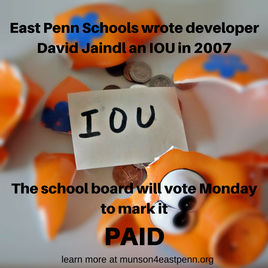
The East Penn School District will vote Monday on an important agreement with real estate developer David Jaindl over the future of land once known as the Romig farm in Lower Macungie Township. Overall I think it is the best among bad options for the district, and I tentatively plan to vote in favor of the agreement. You can read the agreement yourself here (Exhibit #8). In order to help community members understand what is happening, I’ve put together the following list of Frequently Asked Questions (FAQ):
Why does the district need to make this agreement?
The short answer is that it is required to do so under a previous contract that was signed in 2007. The longer answer is that the 2007 contract was a kind of IOU the district gave to Jaindl. The deal put the district on the hook for a number of expensive things, including giving Jaindl 14 acres of land along Route 100, paying the cost of a new road for him, and providing him with the right to purchase additional property at a fixed rate if the district ever sells it. The new agreement to be voted on Monday represents the district settling that IOU.
What are the main elements of the deal?
The district will follow through on its existing legal obligation to give Jaindl 14 acres of land along Route 100, between Sauerkraut and Shoeneck roads. In addition, it will pay Jaindl $1.7 million to settle other terms of the original 2007 agreement, which he may only use for improvements to Sauerkraut Road. The district will also allow additional land-- approximately 8 acres-- to be used for storm water basins to handle runoff from a new Sauerkraut Road extension and redesigned Shoeneck Road intersection. In exchange, the district will have no other obligations to Jaindl or Lower Macungie Township, and Jaindl surrenders his current right to buy remaining parts of the Romig farm property at a below-market price in the future. The district retains ownership of approximately 80 acres in the area for future use, if needed.
What will it cost taxpayers?
The $1.7 million owed to Jaindl will be paid for using funds from its capital reserve, bolstered by proceeds from two recent sales of much smaller properties along Lower Macungie Road. The agreement should therefore have no direct effect on local property taxes or next year’s school district budget. More indirectly, the district will lose 22+ acres of land on this property. But this loss was already built into the 2007 contract that this new agreement replaces. That is, it was part of the IOU the district has owed Jaindl for almost a decade now; it doesn’t represent a new loss to the district or the public.
What does the community get out of the deal?
First and foremost, the community gets to lay to rest the contractual obligations the district has owed Jaindl since 2007. The $1.7 million payment is substantially lower than the district would likely have to pay to build the road required in the 2007 contract, a cost that would only rise in the future. Jaindl gives up future rights to the remaining property as well, making it possible for the district, and thus the community, to get the full value of the land if any more is sold in future years. This agreement also allows much-needed safety improvements to the intersection of Route 100 and Shoeneck Road, which has been the source of significant concerns over the last several years.
What is the history behind this piece of property?
The story of the most recent agreement can be traced back more than a quarter century, when the school district used its power of eminent domain in 1989 to purchase a 108-acre farm along Route 100 owned by the Romig family. The district planned to build a second high school on the property. Instead, the Romigs sued the district, and the resulting public outcry led a reconfigured school board to hastily reverse its decision and return the property to the Romigs-- at substantial cost. Fast forward to 2007. Seventeen years after the first controversy with the Romig farm, the district still faced uncontrolled growth of residential development on former farmland in Lower Macungie Township. Developers were building new housing much faster than the district could accommodate the influx of new students, with no end in sight. The school board was desperate to purchase property in the area large enough to handle several new schools they anticipated would soon be needed. It is in this context that they signed the 2007 contract with Jaindl that gave them ownership over the Romig farm. Jaindl served as a middleman between the school district and the Romig family. In negotiating this new agreement with Jaindl over the last two years, the current school board has insisted that all of the different issues surrounding the property be resolved in a single deal in order to avoid the ‘divide and conquer’ strategy that real estate developers, including Jaindl, have used in the past to work out the best deals for themselves. Doing so gave the district much more leverage in negotiations than they might have had otherwise.
What is the bottom line here?
All of this boils down to a basic question: Is the school district better off under the original 2007 contract with Mr. Jaindl or this new agreement? I currently believe the new agreement is the better one. I describe the deal as “the best of bad options” because I’m saddened to see the further destruction of beautiful farmland in Lower Macungie Township, and I would strongly prefer to use the $1.7 million to improve education rather than roads. At the same time, the original 2007 contract already requires the loss of the same farmland, would cost the district even more money, and allow Jaindl to have continued influence over the remainder of the property. This new agreement thus represents a substantial improvement for our district and our community. I therefore plan to vote in favor of this new agreement unless substantially new information comes to light at the meeting Monday night. |
Details
Categories
All
Archives
December 2017
|

